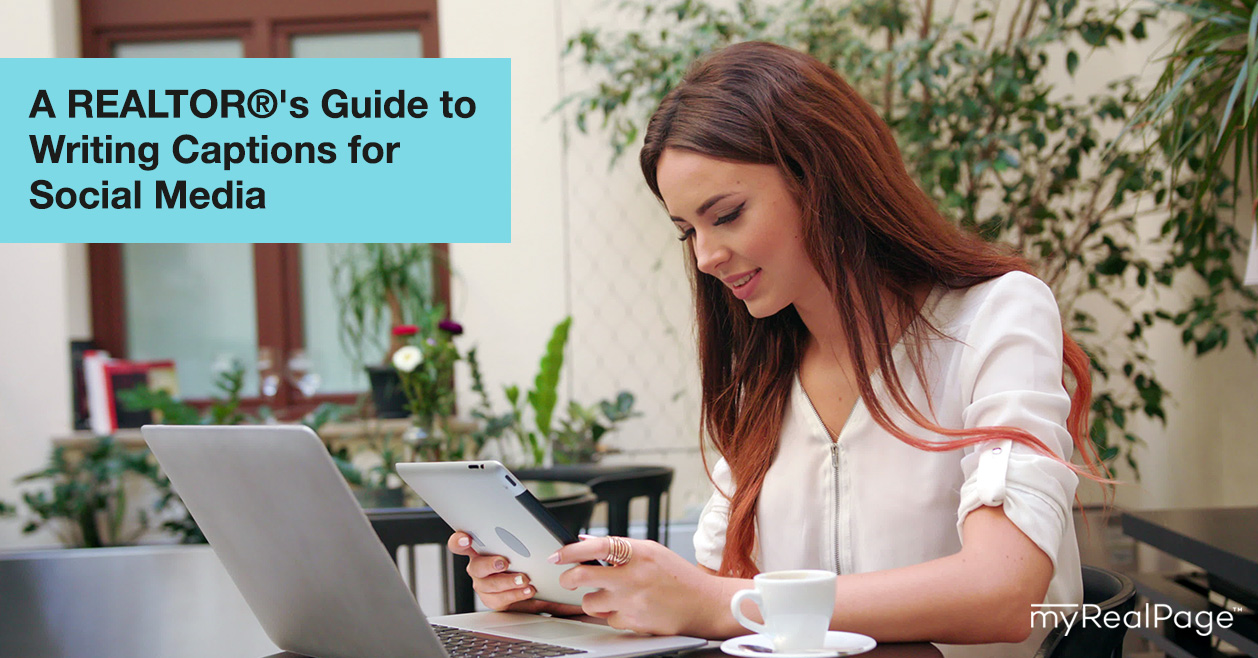A REALTOR®’s Guide to Writing Captions for Social Media

Before you started using social media for your real estate biz, you might have assumed that finding cool content to share would be the hardest part.
And then you started writing captions. 😳
For some people, creating a concise, meaningful and entertaining caption just rolls off the tongue. For other people — for lots of people — writing those captions brings on a bout of intense writer’s block.
If you’re in the latter camp, we’re here for you. This post was written just for you.
May we present: a REALTOR®’s guide to writing captions for social media.
How to Write Captions for Instagram
Instagram may be all about the visuals, but you can’t slack on your captions.
They can be the difference between a post that quickly attracts lots of engagement, and a post that attracts very little. And when an Instagram post gets lots of likes and comments, it is much more likely to be placed high in people’s feeds as per the Instagram algorithm.
Your Instagram caption should provide context for your image or video, show your unique personality and voice, and inspire your followers to like, comment or share your post.
 Later, an Instagram scheduling tool we love, recommends using action words (like “start” and “discover”) and using the Five Ws (who, what, when, where and why) to create an effective call-to-action.
Later, an Instagram scheduling tool we love, recommends using action words (like “start” and “discover”) and using the Five Ws (who, what, when, where and why) to create an effective call-to-action.
Optimal character count: You can use up to 2,200 characters, but you definitely don’t have to. How long your caption is depends on your image or video. A real estate meme only requires a short and snappy caption; a post where you’re sharing important advice might be longer.
Just remember that in the Instagram feed, your caption will be shortened to about two lines; a user will have to tap ‘more’ to read the rest.
Good to have in your caption: Action words; a call-to-action; short sentences; simple phrasing and vocabulary; personality; the occasional emoji; the right hashtags at the end of your caption (between 10 and 30 that are relevant to your business and Instagram post, and that don’t have hundreds of thousands of posts using the same hashtag).
Not good to have in your caption: All caps or all lowercase; dry and formal tone; no connection to the image; spelling and grammar mistakes.
Special considerations: For longer captions, line breaks can improve legibility. Instagram will not automatically create line breaks, even if it looks like you’ve created them. Thankfully, there are some workarounds.
How to Write Captions for Twitter
Not every tweet has an image attached to it. Which means your tweet text needs to be engaging.
When writing a tweet, you want to always ask yourself whether you’d reply, retweet or favourite it if you saw it in your own Twitter feed.
 Your text should be conversational (but still professional) in tone, and should grab attention. Action words (“check out,” “don’t miss”), superlatives (“the coolest”), emotions (“Holy. Moly.”) and intrigue (“you won’t believe”) are all effective ways of grabbing attention.
Your text should be conversational (but still professional) in tone, and should grab attention. Action words (“check out,” “don’t miss”), superlatives (“the coolest”), emotions (“Holy. Moly.”) and intrigue (“you won’t believe”) are all effective ways of grabbing attention.
Retweeting valuable content related to real estate is a good way to mix things up. Just refrain from doing it more than once a day. And don’t forget to reply to any replies!
Optimal character count: In 2017, Twitter increased the caption limit to 280 characters, from the original 140 characters. But brevity always works best on Twitter. Aim for between 70 and 140 characters.
Good to have in your caption: Action, emotion, intrigue and superlatives; simple language and structure; links and photos; a hashtag; an emoji.
Not good to have in your caption: Using more than two hashtags; forgetting that your replies are public.
Special considerations: If you start your tweet with a mention (“@bobsmith You’ll fall in love with this new riverside condo”), only that user will see your tweet. Instead, use their username later in the caption, or put a period in front of the @ sign (ex: .@bobsmith).
How to Write Captions for Facebook
It’s not easy to attract engagement with Facebook these days. The algorithm and competition can make it very, very hard to beat the scroll and get your content seen organically.
Your posts need to feature simple, super concise and eye-grabbing text. And sharing a link, photo or video will almost always increase the reach of your post. Your text can provide content or tease what the follower is about to watch or click on.
 Be selective with what you post; quality over quantity is really important on Facebook. Don’t share mediocre content for the sake of posting.
Be selective with what you post; quality over quantity is really important on Facebook. Don’t share mediocre content for the sake of posting.
Optimal character count: The shorter your Facebook caption, the greater the chance that it will appear in its entirety in someone’s Facebook newsfeed. Try to keep it below 80 characters.
Good to have in your caption: Links and photos; one emoji; brevity; personality; excitement; intrigue; calls-to-action
Not good to have in your caption: Clickbait-style headlines; hashtags; being overly promotional; images not sized specifically for Facebook
Special considerations: Experiment with different kinds of Facebook content — videos, blog posts, quizzes, memes. You never know what might set you apart from competitors and resonate with your audience.
How to Write Captions for Pinterest
Pinterest captions are the descriptions that accompany each pin. They’re important for adding context, but also for driving traffic to your website.
 Pinterest users don’t often edit the existing description when adding a pin to their board; that means your description on your pin (that you upload yourself) could be seen by hundreds or thousands of people if it gets shared.
Pinterest users don’t often edit the existing description when adding a pin to their board; that means your description on your pin (that you upload yourself) could be seen by hundreds or thousands of people if it gets shared.
Your descriptions should contextualize the pin in a brief, informative and click-worthy way. Don’t worry about being funny or clever; focus on convincing Pinterest users that they need to click on the link back to your website.
To create website traffic, your pins need to be found first. Discoverability is important. Pinterest has an autocomplete search bar. Start typing a query and it will suggest how to finish it. Those autocomplete suggestions are popular search terms; use this feature to research what keywords and phrases you can tap into with your descriptions.
Optimal character count: 500 characters is the maximum, but we’d suggest aiming for 200 or so.
Good to have in your caption: Popular keywords and phrases; a link to your website; persuasive descriptions (“Need help?” “Learn now.”)
Not good to have in your caption: No context; no link; skimping on description
Special considerations: Make sure you categorize your pins correctly; a pin that links to your blog post about bathroom renos needs to be pinned to your Bathroom board, not your Backyard Inspiration board. It’s an easy, seemingly small mistake to make, but it can negatively impact that pin’s discoverability.
Do you find it challenging to write great captions? How do you beat writer’s block?
Last Updated on August 12, 2022 by myRealPage


